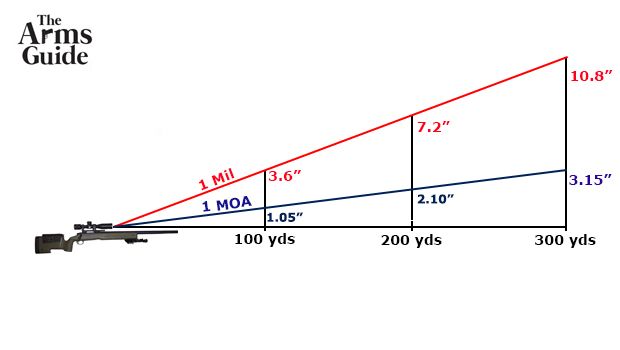If you are into rifle shooting, you may have already heard of the terms “MOA” and “mil”. As this long range shooting series progresses, we’ll see these two terms more and more often, so let’s take some time to talk about what they mean.
MOA and mil are two angular units of measurement, used to quantify sights adjustments, to measure the accuracy of a weapon system, and to determine, using a geometric relation, the distance or the size of a target downrange.
MOA is the acronym of Minute Of Angle (or minute of arc), that is, one 60th of a degree. As you know, a full rotation is composed of 360 degrees. In turn, every degree divides, following the sexagesimal system, in base 60 (like how an hour is divided on a clock). Ergo, a degree divides into 60 minutes of angle, and every minute divides in 60 seconds of angle. A MOA corresponds to 1.047in at 100yds, and 29.1mm at 100m. These values are often rounded to 1” at 100yds and 30mm at 100m, but when shooting long distance, this rounding generates a small, yet noticeable, error. To avoid (or maybe to add?) confusion, the rounded value of 1” at 100yds is referred to as IPHY, or Inches Per Hundreds Yards, while the value of 30mm at 100m is called shooter’s MOA (although, “shooter’s MOA” is sometimes used to refer to the IPHY as well).
Mil is another angular unit of measurement, adopted by NATO forces as a standard for artillery operations (i.e., ranging, targeting, and fire adjustment). One mil corresponds to one 6400th of a full circle. Sometimes, there’s a little bit of confusion about this unit of measurement because fact that the mil measurement is rounded off from the trigonometric milliradian (which is from where we get the “mil” nomenclature), or mrad, which is one 6283rd of a full circle. Need more confusion? The US Marines Corps actually uses the trigonometric mrad for their artillery operations, and have used it in their rifle scope reticles in the past. Fortunately for us, even when shooting a rifle at extreme ranges, the difference between mil and the trig mrad is negligible. At 100m, 1 mil is equivalent to exactly 100mm, and 3.6in at 100yds.
I’ve shared the corresponding linear measures of 1 mil and 1 MOA at the distances of 100yds and 100m. Because mil and MOA are angular units of measure, they don’t correspond to the same linear measurements at every distance. The linear measurement increases, or decreases, proportionally with distance. For example, you have seen that 1 mil corresponds to 100mm at 100m; at 50m, that is, half the distance of 100m, the value of 1 mil corresponds to half of 100mm, which is 50mm. At 500m, five times the distance of 100m, the value of 1 mil corresponds to five times 100mm, which is 500mm. The same concept applies to MOA measurements.
In future articles, I’ll show you how to use the relationship between the angular and the linear measurements to determine the distance of your target, and I’ll guide you in the selection of one of the two systems when you select your rifle scope. But, in the next article, I’ll start talking about a very important subject for long range shooting: the ballistic table. I’ll show you two examples of tables and I will teach you how to read them. It will be the connection between the theory you have studied until now, and the practice that you will encounter shooting on the field.


